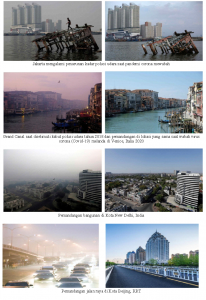Studies have shown various ways in which the Earth is coping with climate change. Air pollution is one of the biggest killers and it is claimed that nearly 7 million people are killed by air pollution every year. However, the COVID-19 pandemic has shown how quickly the world can clean up its air when we stop all the activities we have been doing.
Air pollution has long been one of the factors that damage nature. Even the World Health Organisation (WHO) estimates that nearly 7 million people die each year due to air pollution. Data from WHO also shows that 9 out of 10 people breathe air with very high levels of pollutants that even exceed the threshold set by WHO.
Emissions from fuel combustion where almost ¼ of CO2 emissions are caused by human activity. So, the impact of the transport lockdowns that have taken place around the world due to the COVID-19 striking. According to the International Energy Agency (IEA), average road activity around the world is down almost 50% compared to 2019. Changes in air quality are particularly evident in major cities around the world. At the same time, urban areas recorded a massive reduction in various pollutants related to the combustion of motorised engines.

Sumber foto: https://www.merdeka.com/foto/dunia/1169376/20200421202602-kualitas-udara-sebelum-dan-sesudah-pandemi-mewabah-dunia-004-debby-restu-utomo.html
Data collected by the UK-based National Centre for Atmospheric Science shows a significant drop in nitrogen dioxide (NO2) in several cities around the world. People around the world have also been posting images of clear skies after an estimated 90% of road activity stopped during the lockdown.
Sunil Dahiya from the Centre for Research on Energy and Clean Air says, “The current crisis has shown us that clear skies and clean air can be obtained very quickly if concrete steps are taken to reduce the burning of fossil fuels”. However, as air quality changes rapidly during the lockdown, it can also change back to normal when the lockdown is relaxed or eliminated.
According to research conducted by The World Meteorological Organisation (WMO), the global response to the COVID-19 crisis had little impact on atmospheric CO2 concentrations. Carbon emissions did fall dramatically when transport and industry were significantly reduced, but data from the WMO shows that this only slightly slowed the overall rise in concentrations. The details have been published by the WMO bulletin.
By : Muhammad Abdurrahman Munir





